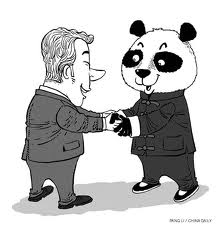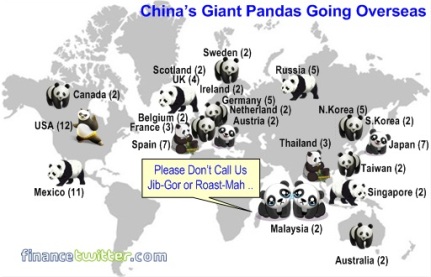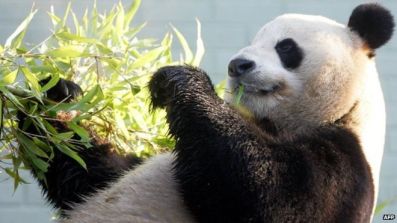PANDA DIPLOMACY
Everybody likes pandas because they are cute, cuddly and very rare. While it looks that they do not do anything else, just sleep and eat bamboo, actually, they play an important diplomatic role for China. For more than half a century, pandas have been sent to zoos in different countries as cuddly ambassadors, to help foster relations with those countries, what has become known as panda diplomacy.
China started the practice of panda diplomacy in 1957, when it sent two pandas as a diplomatic gift to the Soviet Union as a symbol of establishing diplomatic relations between the Soviet Union and the People´s Republic of China. Later in 1972, China gifted another two pandas to the United States after President Richard Nixon´s visit to China. The gift was seen as a huge diplomatic success and establishment of official relations with the U.S. Between 1958 and 1982 China gifted 23 pandas to different countries, such as France, Mexico, North Korea, UK and some others (Duggan J., 2014).
When China realised that numbers of pandas fell, since 1980´s it has stopped giving pandas just as diplomatic gifts. China, instead, began to give pandas to other countries on loan, which is approximately US$ 1,000,000 per year. The loans started to be used for panda conservation facilities and scientific research in an attempt to increase their numbers (Duggan J, 2014).
 After the First Lady Michelle Obama´s trip to China, she said in her blog that “In fact, just last fall, a new baby panda – Bao Bao, which means ´precious´ – was born in the National Zoo in Washington D.C., giving new life to our growing relationship with China. Even for nations as big, complex and different as the United States and China, small gestures can mean a great deal. They can bring people together and help them form bonds that can stretch across the globe” (Brinded L., 2014).
After the First Lady Michelle Obama´s trip to China, she said in her blog that “In fact, just last fall, a new baby panda – Bao Bao, which means ´precious´ – was born in the National Zoo in Washington D.C., giving new life to our growing relationship with China. Even for nations as big, complex and different as the United States and China, small gestures can mean a great deal. They can bring people together and help them form bonds that can stretch across the globe” (Brinded L., 2014).
According to a research paper published in Environmental Practice, panda diplomacy has entered a new phase since 2008, when the Sichuan earthquake devastated the main panda conservation centre. The paper says that in recent years, panda loans are connected with trade deals for valuable resources and technology. There are two types of deals, paper says. The first involves “close Asian neighbour nations that have signed free-trade agreements with China since 2009” and the second involves “nations supplying China with natural resources and advanced technologies” (Duggan J., 2014).
In 2011, two pandas arrived to the Edinburgh Zoo and shortly after the arrival, trade deal worth £2.6 billion was signed for the supply of salmon, Land Rover cars and renewable energy technology to China. After signing the contract, a Scottish government spokesman said: “Strengthening our relationship will bring substantial benefits to both countries. We are committed to working hard to deepen existing ties and establish new areas of cooperation – an approach that is clearly paying dividends” (Hogenboom M., 2013).
The article also says that panda loans to France, Canada and Australia are connected with trade deals for uranium, which China needs for increasing its nuclear capacity by 2050. In 2011, two pandas were sent to Japan as well, and both countries stated that they hope the pandas will enhance friendly feelings and mutual understanding between them, as their relations were soured by a sovereignty dispute over islands (Ibid).
Dr Buckingham said that “the panda can be used to seal the deal and signify a bid for a long and prosperous relationship. If a panda is given to the country, it does not signify the closing of a deal – they have entrusted an endangered, precious animal to the country, it signifies in some way a new start to the relationship.” She also argues that China is interested to have “soft power influence through a global visual seal of approval” gained from loaning pandas (Ibid).
As we can see, a new phase of panda diplomacy has made it evident that China has a lot to gain through panda loans. China´s expansion and its use of panda diplomacy have become more interlinked and motivations behind panda loans have become more unclear. It is obvious that they are no longer just about conservation and diplomatic gifts, but become to the big extend bound up with political and economic aims.
References:
Brinded L., March 2014, Panda Diplomacy: How China Uses Animal to Get What it Wants, International Business Times
http://www.ibtimes.co.uk/panda-diplomacy-how-china-uses-pandas-try-get-what-it-wants-1442721, accessed May 2015
Duggan J., February 2014, China´s cuddly ambassadors with diplomatic clout, The Guardian
http://www.theguardian.com/environment/chinas-choice/2014/feb/27/china-panda-diplomacy, accessed May 2015
Hogenboom M., September 2013, China´s new phase of panda diplomacy, BBC News
http://www.bbc.co.uk/news/science-environment-24161385, accessed May 2015
China Daily, February 2011, Panda diplomacy likely to boost ties, China.org.cn
http://www.china.org.cn/environment/2011-02/22/content_21972414.htm, accessed May 2015

I really liked the blog entry and think that panda diplomacy is a good way for china to show that it is not always about hard power and that small gestures can go a long way. However in my opinion you could improve your blog entry even further by focusing less on the economic benefits that China can gain by the use of Pandas and more on the diplomatic aspect. Maybe by including why China is in need for soft power and how it could improve chinas image.
LikeLike
Really interesting as an informative post, although could possibly give others examples of animal’s diplomacy, and just briefly state the truth behind such a ‘kind gestures’, in a sense of not just what they gained, but your point of view on a long term relationship within those countries. The truth beyond China’s increase on its nuclear power? or, How will the Russia see China as a greater nuclear power in a couple of decades?! Is China interested in a multilateral image?! if so, I guess it could be slightly more interesting in a sense of ‘threats behind the kindness’.
LikeLike
Pingback: CHINA’S PANDA DIPLOMACY: SOFT POWER AND IMAGE MANAGEMENT – talkchinesediplomacy